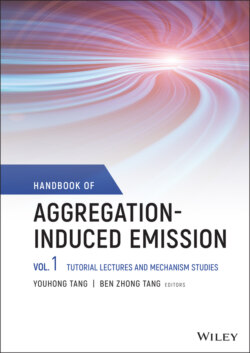Читать книгу Handbook of Aggregation-Induced Emission, Volume 1 - Группа авторов - Страница 40
2.4.1 Stokes Shift vs Reorganization Energy
ОглавлениеThree representative AIEgens, 9,10‐distyrylanthracene (DSA) [54], 2,3‐dicyano‐5,6‐diphenylpyrazine (DCDPP) [55], and cis,cis‐1,2,3,4‐tetraphenyl‐1,3‐butadiene (TPBD) [56] in both solution phase (PCM model) and crystal (QM/MM model), were investigated at the PBE0‐D3(BJ)/6‐31G(d) level [57]. According to the Franck–Condon principle, the maximum peak of the optical spectrum usually appears at the vertical transition point (Figure 2.5a); the Stokes shift (κ) between the absorption and emission maxima can be regarded as λtotal, which is the sum of the reorganization energy of the ground (λgs) and excited state (λes). Then, the emission energy can be written as Eem = Eabs − λtotal. Upon aggregate from solution, the shift of the emission spectrum can be regarded as:
(6)
The common red‐shift spectra of the ACQ molecule originate from ΔEagg − sol < 0 for both absorption and emission and the tiny change in reorganization energy (). However, for AIEgens, the abnormally blue‐shifted emission occurs from the significant difference environments between the isolated molecule and aggregated phase. In AIEgens, the λtotal in the aggregate is usually much smaller than that in the solution phase, that is, , while in the absorption spectra of AIEgens in two phases are close to zero. As a result, the emission spectrum blue‐shifts with ; see Figure 2.5.
Figure 2.5 (a) The schematic representation of the adiabatic potential energy surface of the S0 and S1, as well as the corresponding vertical excitation energies. (b) The relative wavelength of AIEgen in both solution and aggregated state.
The optical properties and reorganization energies are summarized in Table 2.4. It is clear that, upon aggregation, the change of absorption spectra is tiny, while the emission spectra blue‐shifted obviously. Thus, the κsol is much larger than κagg. According to the approximately equivalent relation between κ and λtotal, as shown in Table 2.4, is larger than . Thus, the blue‐shift emission is caused by the larger λtotal in solution than that in aggregate. Structural analysis and reorganization energy analysis reflect the key role of dihedral angles, and the restriction of low‐frequency rotational or twisting vibrations blocks the nonradiative decay channel and makes the light to emit.
